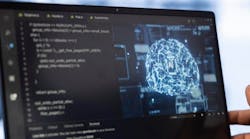Beyond Tariffs: The Governance Mandate Driving U.S. Manufacturing’s AI Revolution
Key Highlights
- Manufacturing in America is shifting towards technological reinvention, emphasizing AI, automation, and advanced analytics to enhance agility and competitiveness.
- Reshoring is not just geographic but involves redesigning factories with responsible governance, focusing on explainability, security, and regulatory readiness.
- Building trust in AI systems requires transparency, cybersecurity measures, and adaptable compliance strategies to meet evolving regulations.
- Operational resilience and human oversight are critical to managing AI-driven processes, ensuring systems can recover from disruptions and maintain accountability.
Manufacturing in America is no longer a conversation about offshoring versus reshoring. It’s about reinvention. We’re watching an entire sector recalibrate, and it’s not just because of economic pressures, but because of technological ones.
In recent months, an already delicate U.S./China trade truce has grown more fragile. Tensions have escalated around semiconductor policy, new tariffs are looming on critical battery materials, and key ports are seeing dramatic drops in volume. As major retailers warn of price increases and multinational firms hit pause on investments, the message is clear: global supply chains are entering a period of sustained uncertainty.
Companies are accelerating plans to bring production back to U.S. soil in response. But reshoring today is more than a geographic decision. It’s a technological bet. The reality is that domestic manufacturing must be more intelligent and agile to be cost-effective. That’s where the convergence of AI, automation, and advanced analytics comes in.
The challenge, and the opportunity, is how to do this responsibly.
A New Industrial Equation
This next generation of manufacturing will be driven by real-time data, predictive models, robotics, and self-learning systems: AI is managing procurement, automation is optimizing production, analytics are reducing waste and forecasting disruptions before they occur.
This is a profound transformation. But it also raises a critical question: Can we trust the systems now making high-impact business decisions?
That’s no longer a philosophical exercise. Accountability becomes an operational necessity when AI determines where goods are sourced or how materials move through the supply chain. And the consequences of failure – regulatory penalties, cybersecurity breaches, reputational damage – are anything but theoretical.
If we trust machines with core business functions, we need new standards for how they’re governed.
Reshoring Isn’t a Reset – It’s a Redesign
Many organizations are quickly realizing that bringing operations home means more than reopening old factories. It means rethinking how those factories work. Rising wages, an aging workforce, and labor shortages make full reliance on human labor unrealistic. Companies need intelligent systems that can do more with less to compete globally.
But this is more about responsibility than efficiency. In this new model, organizations must be able to explain how decisions are made, secure the infrastructure that powers them, and prove compliance to an increasingly complex patchwork of regulations.
Many organizations are quickly realizing that bringing operations home means more than reopening old factories. It means rethinking how those factories work.
This is where governance becomes foundational.
A Framework for Responsible Innovation
Building trust in AI and automation demands holistic oversight. Here’s where manufacturers and supply chain leaders are focusing their efforts:
1. Explainability and Auditability
AI is only as trustworthy as it is understandable. Whether routing materials or determining production schedules, algorithms must be explainable. Business and technical leaders should be able to trace how decisions are made, under what parameters, and with what data. This is especially crucial as regulatory scrutiny increases. Black-box systems may perform well, but if they can’t be audited, they’re a liability.
2. Security at Scale
As more devices, systems, and sensors become connected, the attack surface is expanding. AI systems are also increasingly targeted by adversarial attacks – efforts to subtly alter inputs to manipulate outcomes. As a result, cybersecurity strategies need to be deeply embedded in AI development and deployment. Regular validation, robust access controls, and real-time monitoring are critical to ensure that automation doesn’t become a backdoor for disruption.
3. Regulatory Readiness
Between evolving AI guidance frameworks, export control policies, and industry-specific compliance regimes, regulatory demands are growing more complex. Companies must be prepared to meet both existing and emerging requirements to avoid penalties and demonstrate accountability to customers, partners, and investors. Regulatory agility, being able to adapt to new rules quickly, is emerging as a competitive differentiator.
4. Resilience Planning for Intelligent Systems
Operational resilience means preparing for digital disruptions – AI model drift, data anomalies, and system failures. Manufacturers need clear protocols for identifying when automation is underperforming or misaligned, and for quickly returning to human oversight when required. This also includes stress testing systems under simulated adverse conditions.
The Role of People in a Machine-Led Model
There’s a myth that AI replaces people. The reality is, it reshapes how people work and often elevates the importance of human oversight. Data scientists, compliance officers, engineers, and even floor operators all play a role in ensuring systems are used responsibly.
Equally important is culture. Organizations that embed ethical decision-making into their innovative practices are more likely to spot blind spots early. Cross-functional collaboration – between IT, legal, operations, and compliance – creates a stronger foundation for trust. And leadership must set the tone by prioritizing responsible design and deployment.
What’s at Stake Isn’t Just Output, It’s Trust
Tariffs may be driving the urgency around reshoring, but they’re not the full story. What’s unfolding is a broader transformation in how manufacturing happens and in who or what makes the decisions.
AI isn’t just optimizing processes; it’s influencing strategies, balancing risks, and making choices that affect real-world outcomes. That means trust must be engineered into every layer, from data governance to system resilience to stakeholder communication. We’re entering an age where trust is no longer assumed. It must be earned and proven.
Looking Ahead
Organizations that succeed in this new era will be those that treat trust as a strategic priority. That means investing in security. It also means designing AI systems with explainability in mind from the outset. And it means preparing for disruption with contingency plans and confidence in the systems.
Most importantly, it means recognizing that this moment isn’t just about adapting to change. It’s about leading responsibly, transparently, and clearly understanding that how we build matters just as much as what we build.
Manufacturing may be coming home, but the future we’re building requires more than geography. It requires governance. And in that future, trust won’t be a byproduct but rather the standard.
About the Author

Avani Desai
Chief Executive Officer at Schellman
Avani Desai is the Chief Executive Officer at Schellman, a global cybersecurity assessment firm focusing on technology assessments. Avani is an accomplished executive with domestic and international experience in information security, operations, P&L, oversight, and marketing involving start-up and growth organizations. She has been featured in Forbes, CIO.com, and the Wall Street Journal. She is a sought-after speaker as a voice on various emerging topics, including security, privacy, information security, future technology trends, and the expansion of young women involved in technology.
Also passionate about strategic philanthropy, Avani sits on the board of Arnold Palmer Medical Center, Philanos, is the chairwoman of the Audit Committee at the Central Florida Foundation and is the co-chair of 100 Women Strong, a female-only venture capitalist-based giving circle that focuses on solving community-based problems specific to women and children by using data analytics and big data.



